A guide by local experts with the best things to see, do and eat in Argentina's Capital
Let’s get this out of the way first: Buenos Aires is a pretty big city. We always tell visitors to stay as long as they can before hopping on a plane to Iguazú Falls or Patagonia. Ideally, you want to stay at least a week in town, but if you can’t, fear not: we’ve got you covered.
Our 3 day Buenos Aires itinerary is packed tight with must-see attractions, hidden gems and the best spots to grab a bite or a cup of coffee (because here, food is a highlight in itself).
Day 1: Recoleta and Palermo
Since most international flights to Argentina land in Buenos Aires, many travelers tend to be a little bit jet-lagged after the long journey to the south. We recommend Recoleta and Palermo for your first day of your Buenos Aires Itinerary, so you can start your sightseeing while catching a much-needed break.
Recoleta Cemetery
An unorthodox first stop, I know, but not without reason: Recoleta Cemetery is one of the most impressive necropolis in the world and a location you can’t miss.
The crème de la crème of Buenos Aires society is buried here, with its most famous resident being former First Lady Eva Perón (don’t know her? Watch “Evita” with Madonna and Antonio Banderas: not the most accurate historical account of her life, but by all means the most gorgeous, and certainly the most fun).
The cemetery has it all: intricate architecture, eerie stories, intriguing statues and one or two tales about ghosts. If you are lucky, you may even spot one of the elusive cats that roam the mausoleums, usually in search of unsuspecting pigeons.
Recoleta Cemetery Tips:
- There’s an entry fee - as of 2022, international visitors must pay an entry fee of about $10 USD (credit card only) which can be booked in advance or paid upfront.
- Join a tour - the dead don’t talk, so going with a (living) guide to show you around is the best way to explore the cemetery, learn a little about Buenos Aires history and get some great - and spooky - stories.
- Mind the climate - it gets very, very hot during the summer and late spring. Go hydrated, cover your head and wear sunscreen if you are prone to sunburns.
The cemetery is usually open from 9am to 5pm, but make sure to double check before going as it may be closed or closing earlier during holidays.
Breakfast/early lunch at La Biela
There are many good options for breakfast or an early lunch close to the cemetery. There’s always the iconic La Biela, one of the city’s “notable cafes”, a Recoleta classic that older residents are very fond of. It’s a bit on the pricier side, but it has a lovely view of the cemetery and the park, as well as the historic gomero (gum tree), rumored to be the oldest tree in the city.
If you are looking for something more modern, there’s La Panera Rosa right in front of La Biela (part of a coffee chain, but quite decent food) or head to the nearby Recoleta Mall for more options (Pani and Le Pain Quotidien).
Time for a stroll: Floralis Generica, Law School and Plaza Leloir
The cemetery is surrounded by several parks and green areas, and more than a handful of cultural landmarks (like the Recoleta Cultural Center, which paints its facade with different motives every season). You can head down to the Floralis Generica - a gigantic, metallic flower - in the United Nations Square across Alcorta Avenue.
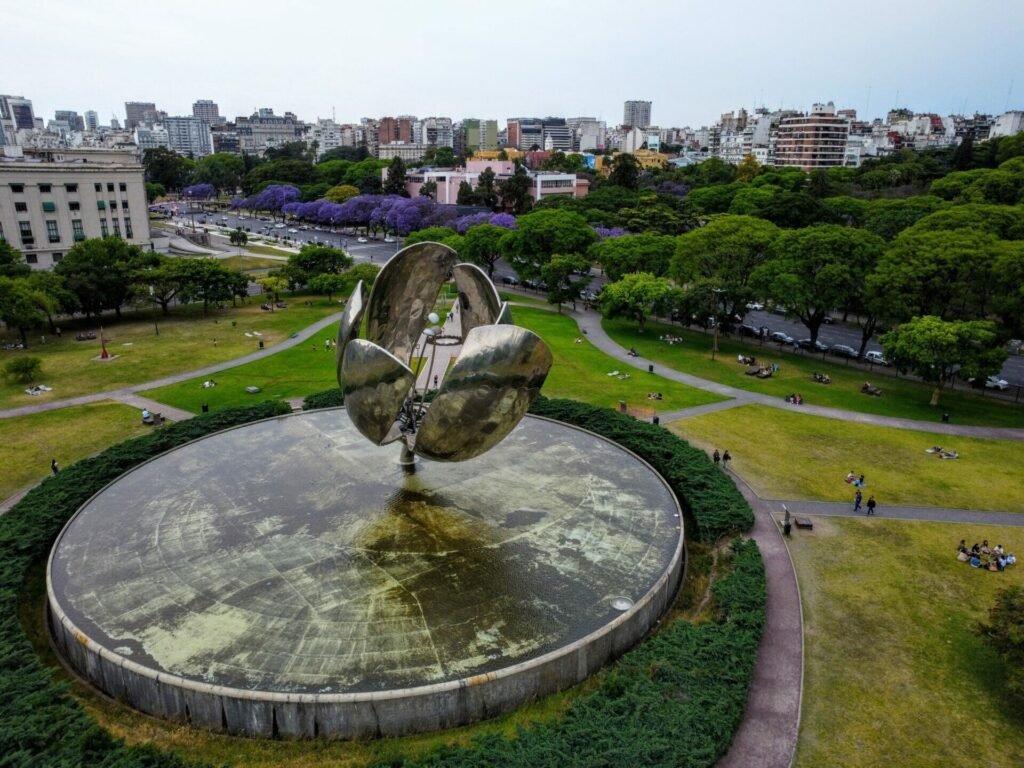
To get there, cross the pedestrian bridge next to the University of Buenos Aires’ Law School (more column than building) - don’t miss the chance to snap the perfect panoramic picture from above the avenue. During springtime (November and early December), the avenue turns purple because of the blooming jacaranda trees.
After the floralis, you can go up to the National Library, a more recent addition to the neighborhood that is loved and loathed in equal measure. The brutalist building opened in 1992, and at first glance clashes with the Parisian-style architecture of the area. The view from the library, however, is unmatched, be it for weary students of sightseeing visitors.

Right next to the library is a secluded residential area known as La Isla (the island), set apart from the rest of Recoleta because it can be (mostly) only accessed by steps. Check out the lovely Plaza Leloir and the British Embassy.
- Sherpa Tip: There’s a fantastic bar right next to the National Library called Invernadero, perfect for a cup of coffee or a glass of lemonade, depending on the season.
El Ateneo Bookstore
Buenos Aires is famously the bookshop capital of the world, but if you can only visit one, let it be El Ateneo Grand Splendid. The architecture of the former theater has been preserved, and one can peruse the shelves at leisure while wandering about the giant bookstore. There’s also a café if you want to stay for a little longer. This is a good place to grab a souvenir, as prices, while not cheap, are standard.
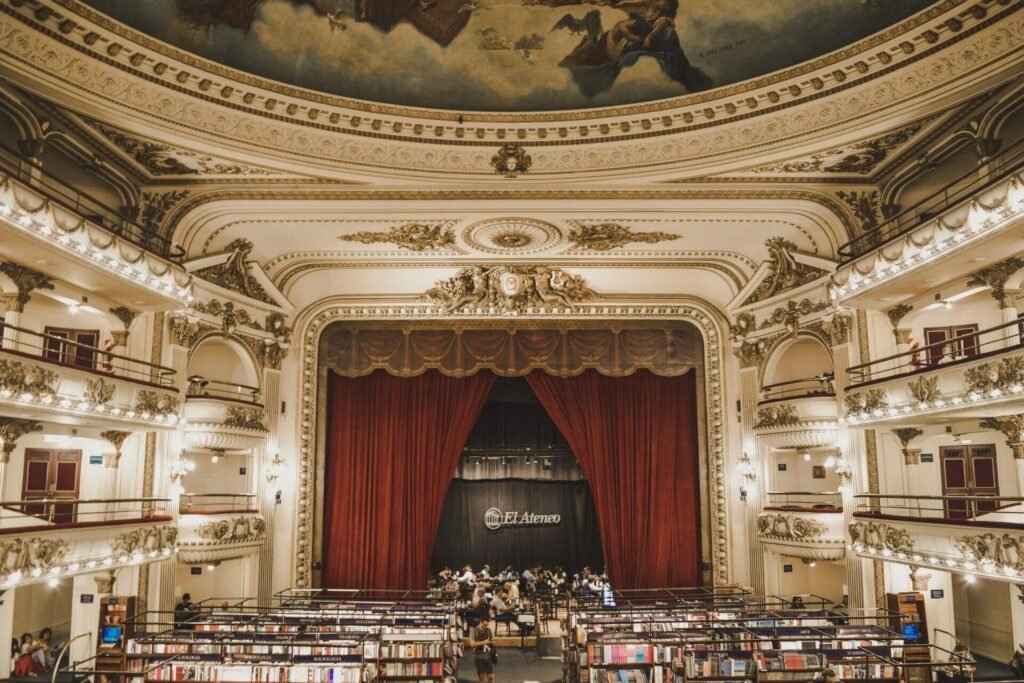
Palaces and Opulence in Avenida Alvear
If you are up for some walking, the Avenida Alvear boasts some of the most opulent buildings in the city. There’s the Duahu Palace, the Alvear Palace, the Vatican Embassy and the main Headquarters of the Jockey Club, a gentlemen’s club that to this day remains a symbol of the Argentine elite.
- Sherpa Tip: The Dos Escudos Bakery is right around the corner. This classic, old-school bakery is famous for its sandwiches de miga (soft white bread sandwiches with the crust removed; just trust us on this one) and its fosforitos (tiny ham & cheese puff pastry sandwiches).
Take to the Palermo Streets
Palermo is the biggest neighborhood in Buenos Aires, so it is no surprise that, in time, many smaller Palermos have sprouted from within: Palermo Soho, Palermo Hollywood, Palermo Viejo…
Palermo Soho is one of the trendiest areas in town, which makes for a nice contrast with classy Recoleta. This hip neighborhood is known for its colorful street art, the coolest shops and as many cafés and restaurants as you want.
Unlike Recoleta, Palermo is not so much about “visiting” places but enjoying a moment. Porteños come to Palermo for a good time and some great food.
Capturing the magic of Palermo can be tricky if you don’t know your way around, but luckily, there’s a shortcut: our Palermo Food Tour, voted Trip Advisor’s 2023 Best Culinary Experience in Argentina (and #6 in the entire world!). This is the perfect introduction to Buenos Aires culture, featuring fantastic local dishes, iconic restaurants and a stroll through the hippest streets in the city.
PS: if you liked Palermo and have some spare time to spend in the city, check out these top 10 things to do in Palermo - we've covered activities, key locations, and places to grab a bite or a drink.
Day 2: Plaza de Mayo and Downtown
The second day in our 3 day Buenos Aires itinerary is all about history - we are going to Plaza de Mayo and the Microcentro (Downtown). We’ve planned a busy day, so it’s best to start early.
Plaza de Mayo
Plaza de Mayo is not only the foundational site of Buenos Aires city, it has also borne witness to several decisive moments in Argentine history, as well the largest demonstrations in the entire country.
The square and its May Pyramid are a political and cultural landmark of immense relevance, as well as a symbol of Argentina’s democracy and freedom.

Plaza de Mayo is surrounded by historic locations such as the Casa Rosada, seat of the executive power, the historic Cabildo (old town council) and the Metropolitan Cathedral.
Plaza de Mayo Tips:
- The Cabildo is free to visit, and the upper floor offers a panoramic view of Plaza de Mayo and the Metropolitan Cathedral.
- Visit the Catedral. The remains of national hero San Martín are buried here, the grave guarded by the granaderos, a cavalry unit founded by San Martìn himself and currently the presidential Honor Guard.
- Watch the guard shift. The granaderos also guard the Casa Rosada, and they exchange shifts every two hours from 7am to 9 pm at Plaza de Mayo.

Breakfast time at Café Tortoni or London City
Two of Buenos Aires' most notable cafés are right around the corner.
There’s Café Tortoni, founded in 1858 and to this day one of the most impressive establishments in the city. The impressive decor and architecture will take you back to the golden days of Buenos Aires and are reminiscent of classic Parisian Grand Cafés. Order some hot chocolate with churros and enjoy the ambiance.
The other option is London City, a charming café that has been around since the 1950s, and an iconic location once favored by beloved author Julio Cortázar. The best things on the menu are the cakes and the pastries: pair them with a good cup of coffee and your day will be off to a great start.
- Sherpa Tip: for a typical porteño, order a cup of coffee with three medialunas (think croissants, but smaller). Dipping your medialuna in the coffee is optional, but highly recommended.
San Ramón Nonato Convent
A quiet oasis hiding in plain sight, the Convent of San Ramón Nonato is located on Reconquista Street, just a few blocks away from Plaza de Mayo. The convent has a beautiful garden, perfect for catching a break from all the sightseeing.
Despite its name, the place is no longer the home of the Mercedarios order of monks (who still manage the place) but a hub for arts and culture. The cloister is lined with antiques and crafts shops, a library and two restaurants.
Colón Theatre
A relic of Argentina’s gilded age, the Colón Theater is an architectural masterpiece and an incredibly beautiful sight. The English tour takes an hour and you learn a lot about the building, its history and design. The entry fee is pricier for tourists, but is not overly expensive. If you are lucky, you may even catch sight of a rehearsal or photo shoot, but it’s still a great sight nonetheless.
Tickets can be purchased online or in person with a credit card. They only accept pesos for cash payments.

The Obelisk
On your way to the Colón, stop and snap a picture of the Obelisk at 9 de Julio Avenue. The monument stands as THE symbol for Buenos Aires, and a meeting point for soccer fans when their team wins. After Argentina won the 2022 world cup, almost the entire city headed to the Obelisk to celebrate, with some intrepid (and most likely inebraited) individuals even climbing the monument.
- Sherpa Tip: Some of the best pizzerias in town are located in Avenida Corrientes, close to the obelisk. Head to Güerrín, Las Cuartetas or Banchero for a slice of cheesy pizza.
Centro Cultural Kirchner
Known to the locals as “CCK”, the former Post Building houses the biggest cultural center in the city, with an ever-changing selection of exhibitions, events and festivals. Entry to the CCK is free, and the building’s rooftop offers a spectacular view of Puerto Madero and the Downtown.
The fourth floor of the CCK also houses the Eva Perón Room, a reproduction of the former First Lady’s Office in the then Post and Telecommunications Palace.
This is a huge and beautifully preserved building: if you plan on visiting, make sure to check the center’s cultural calendar ahead of time, as you may be able to attend a concert or function (which are all free, you just have to book the tickets online ahead of time).
Plaza San Martín
We are ending our second day on Plaza San Martín, one of the oldest squares in the city, and the most impressive park in Retiro. Next to the square is the Kavanagh Building, a testament to art deco and once the tallest building in Latin America.
Plaza San Martín is quiet and lusciously green. A giant ancient gomero tree sits in the middle of the square, and several jacaranda trees patiently await springtime to turn the whole square purple. Sit down and relax at the square, or grab an ice cream at Rapa Nui, one of the best ice cream shops in the city.
Take the rest of the day off to relax, go shopping or a much-needed nap. If you still have room for dinner, check out our guide to the best Steakhouses in Buenos Aires or read our Buenos Aires Food Guide for some inspiration.

Day 3: San Telmo and La Boca
Last but not least, San Telmo and La Boca await you for the final day of your Buenos Aires Itinerary. While both are part of the old town, each neighborhood has its own distinct vibe. After yesterday’s marathon through downtown Buenos Aires, you can sleep in and get down to San Telmo in time for lunch.
San Telmo: cobbled streets, food market and antiques
One of the oldest neighborhoods in the city, and perhaps the most charming, the cobbled San Telmo streets are a mix of bohemian flair and nostalgia that never fails to captivate locals and tourists alike.
The neighborhood is famous for its association with tango, the San Telmo Market, the Sunday fair and its colonial architecture. The area is not only ideal for some souvenir treasure hunting, but a culinary hub with plenty of great options to choose from.
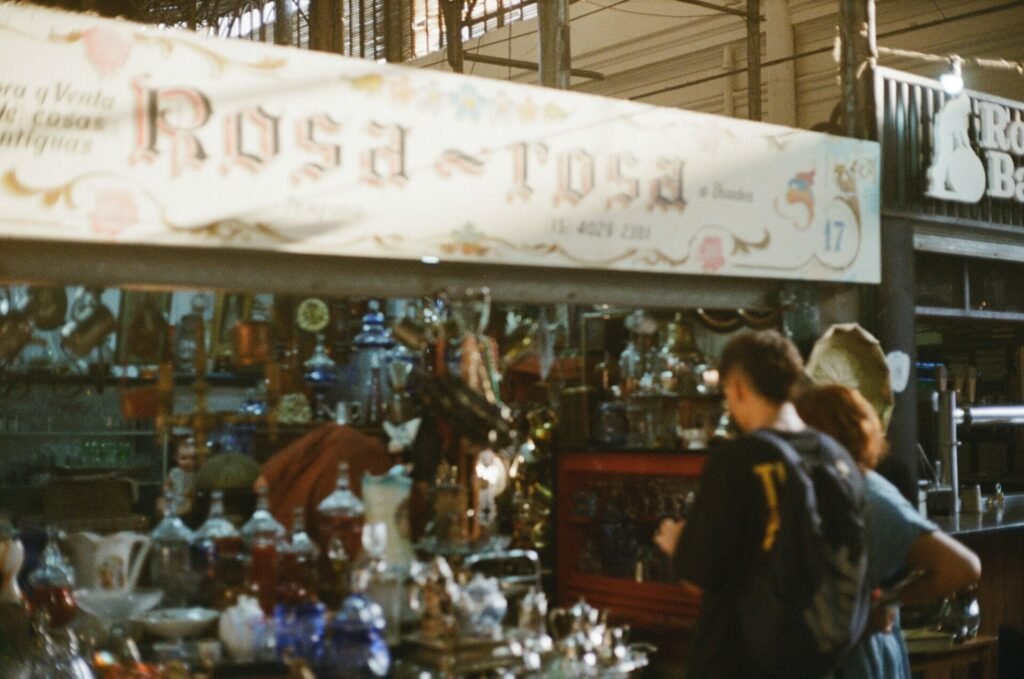
Plaza Dorrego and Defensa Street Fair
The main square of San Telmo is the iconic Plaza Dorrego, known for its antique market and impromptu tango shows. The place is particularly busy sundays, as the sunday fair in Defensa Street brings in a huge crowd from all over town.
Sundays are therefore great for those looking for a fun and lively outing (although somewhat crowded). Weekdays and Saturdays tend to be more relaxed, and you can explore the area at your own pace.
San Telmo Market
The historic indoor market offers an eclectic mix of stalls, from antiques to fresh produce. The place has been in business since its opening in 1897 to serve the new waves of European immigrants, and although it has been updated, the internal structure remains untouched. The area experienced a gourmet boom in recent years, which means that not only can you pop in to browse the shops, but you can also grab a quick - and tasty - bite.

Culinary Scene
San Telmo is also home to many bodegones, signature “diner-style” Buenos Aires restaurants that are known for their hearty homestyle food and retro decor. Not to mention the abundance of corner-side cafés luring you in with the smell of roasted beans and fresh medialunas.
To enjoy San Telmo to the fullest, we highly recommend our San Telmo Food Tour. This is a walking lunch tour that will take you restaurant hopping through San Telmo, featuring traditional dishes and drinks (including, of course, steak and malbec) and some modern takes on Argentine cuisine. As you make your way from one restaurant to another, you’ll learn all about the history of the city and its vibrant culture.
If you want to spend more time in this part of town, check out our pick of the best things to do in San Telmo, which covers the area in detail.

La Boca: Caminito, Bombonera and PROA foundation
No Buenos Aires itinerary is complete without a visit to Caminito, La Boca’s most colorful corner and an iconic tango reference. Is this place a tourist trap? Yes. Is it worth visiting? Absolutely.
La Boca residents - dock workers, fishermen and sailors - used to build their houses with scrap materials and painted them with leftover paint from the ships. Artist Benito Quinquela Martín revived this practice in the 1950s, bringing back color into La Boca.
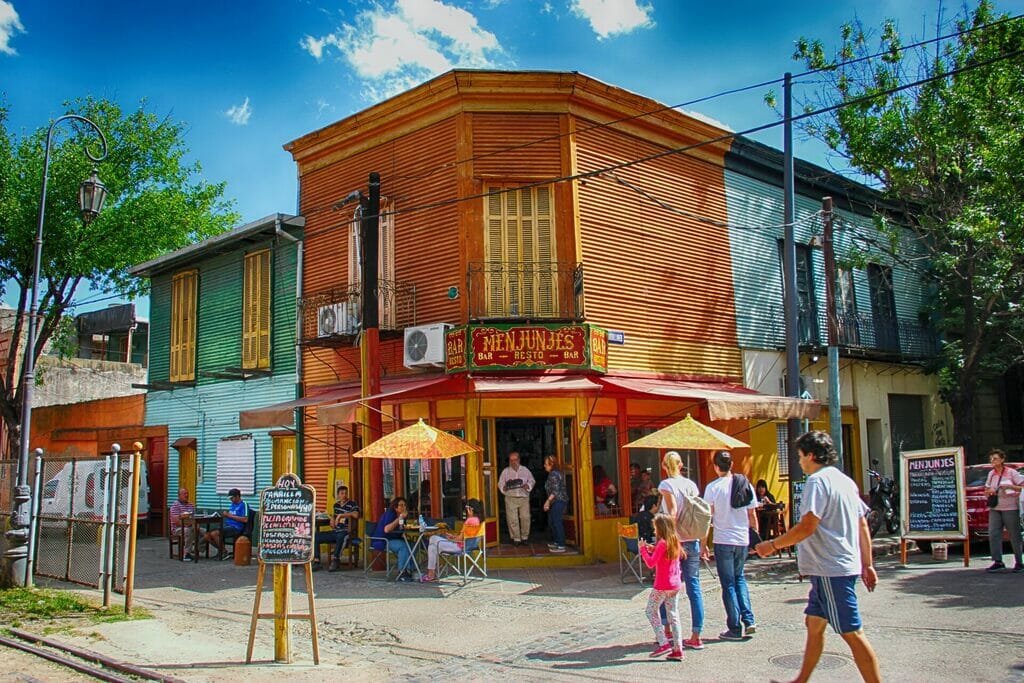
Much like Barracas and San Telmo, La Boca was once inhabited by wealthier porteños, but the city’s rich fled the area during the yellow fever outbreak in 1871. The homes they left behind later become “conventillos”: each room was rented out to an entire family or large group of people, giving room to crowded and complex living arrangements.
Nowadays, the conventillos on Caminito have been upcycled into souvenir shops, each one more colorful than the other.
Back on the street, tango performers dressed to the nines will be waiting to showcase their skills for tips and applause, and you can even take a picture with them for a small price.
- La Boca Tip: Stay within the Caminito circuit. Pickpockets await on the less tourist-y streets of La Boca.
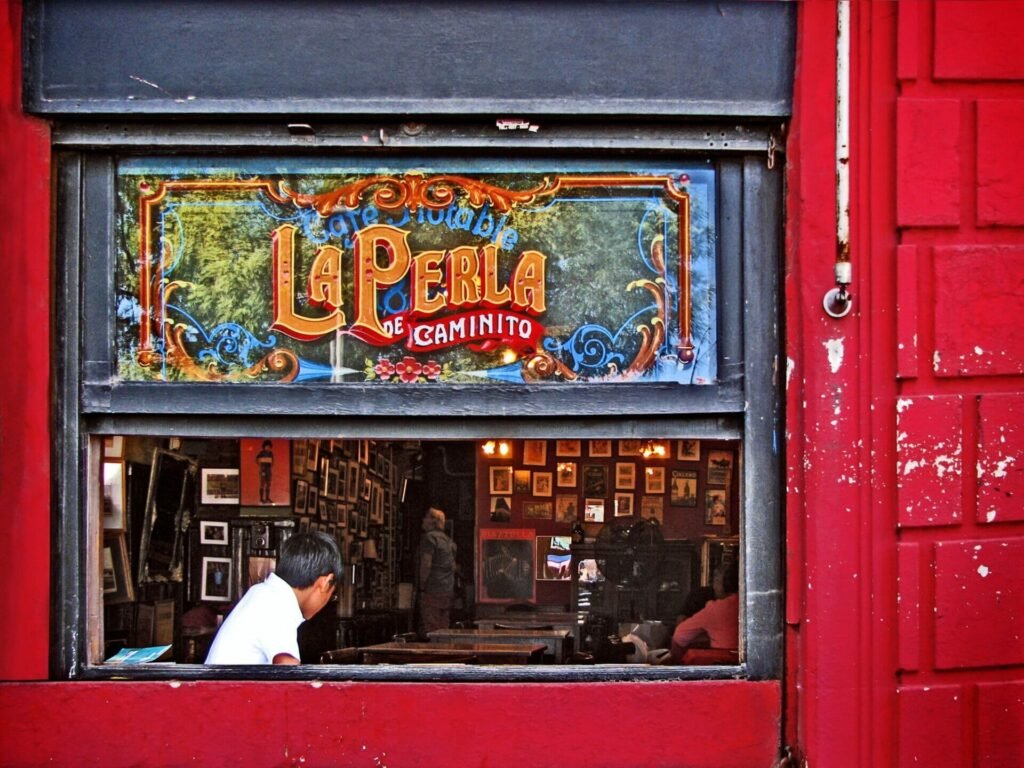
La Bombonera
Argentina is known for a few things: steak, tango and fútbol (we don’t like calling it soccer, but we’ll do it since we are being nice). This means that you can’t leave without at least visiting a stadium, and few are as emblematic as La Bombonera (which literally means “chocolate box”).
Sadly, access to the stadium itself has been removed because of ongoing reforms, but the museum is still open to visitors. Aptly named “museum of Boca’s passion”, visitors will leave with a better understanding of Argentina’s ongoing love affair with soccer (and legendary superstar Diego Maradona).
Of course, you still have the option of going to a game, but seats go fast and getting one is quite expensive.
PROA
To end the day on a good note, head down to the PROA foundation. The terrace café on the third floor has a fantastic view of the old docks and the river. The PROA is known for its contemporary art exhibitions, so you can also take a look around while you are at it.
Buenos Aires Itinerary FAQs
Below you’ll find some helpful info and FAQs to prepare for your trip.
How to get around Buenos Aires
If you are in town for just a few days and don’t want to deal with the intricacies of the public transport system, you can grab a taxi (black and yellow cars) or, alternatively, use a rideshare app such as Uber or Cabify. If you want to use the underground system or buses, you will need a SUBE card, which you can buy at some kiosks, subte (subway) stations and Tourist Assistance Centers.
Is Buenos Aires expensive for tourists?
Depends on where you are coming from. US-Americans and Europeans usually find the exchange rate pretty favorable. Our economy is not known for its stability, however, so take this answer with caution. Right now (June 2023), prices for tourists are very affordable.
Is Buenos Aires safe at night?
Buenos Aires is a huge metropolis, and it is overall pretty safe as long as you take some basic precautions. Don’t wear expensive jewelry and don’t leave your phone or wallet in exposed outer pockets and leave your valuables in your hotel safe. If in doubt, take a cab, uber or cabify to get to your destination.
